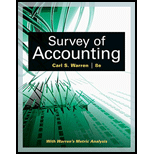
Concept Introduction:
Stocks (Common Stock and Preferred Stock):
There are two types of the share capital of a company. Common Stock represents the Common shares issued to the shareholders and preferred stock represents the
Requirement-a:
To Indicate:
The effect of the given transaction o the revenue and expense
Concept Introduction:
Stocks (Common Stock and Preferred Stock):
There are two types of the share capital of a company. Common Stock represents the Common shares issued to the shareholders and preferred stock represents the preference shares issued. Preference shares are given preference in payment of dividends and repayment of capital. Common shareholders get the inbuilt right to vote in decisions of the company and preference shareholders generally do not get this right but they may get voting rights with special provisions.
Requirement-b:
To Indicate:
The effect of the given transaction on the stock holder's equity
Want to see the full answer?
Check out a sample textbook solution
Chapter 8 Solutions
Survey of Accounting (Accounting I)

 AccountingAccountingISBN:9781337272094Author:WARREN, Carl S., Reeve, James M., Duchac, Jonathan E.Publisher:Cengage Learning,
AccountingAccountingISBN:9781337272094Author:WARREN, Carl S., Reeve, James M., Duchac, Jonathan E.Publisher:Cengage Learning, Accounting Information SystemsAccountingISBN:9781337619202Author:Hall, James A.Publisher:Cengage Learning,
Accounting Information SystemsAccountingISBN:9781337619202Author:Hall, James A.Publisher:Cengage Learning, Horngren's Cost Accounting: A Managerial Emphasis...AccountingISBN:9780134475585Author:Srikant M. Datar, Madhav V. RajanPublisher:PEARSON
Horngren's Cost Accounting: A Managerial Emphasis...AccountingISBN:9780134475585Author:Srikant M. Datar, Madhav V. RajanPublisher:PEARSON Intermediate AccountingAccountingISBN:9781259722660Author:J. David Spiceland, Mark W. Nelson, Wayne M ThomasPublisher:McGraw-Hill Education
Intermediate AccountingAccountingISBN:9781259722660Author:J. David Spiceland, Mark W. Nelson, Wayne M ThomasPublisher:McGraw-Hill Education Financial and Managerial AccountingAccountingISBN:9781259726705Author:John J Wild, Ken W. Shaw, Barbara Chiappetta Fundamental Accounting PrinciplesPublisher:McGraw-Hill Education
Financial and Managerial AccountingAccountingISBN:9781259726705Author:John J Wild, Ken W. Shaw, Barbara Chiappetta Fundamental Accounting PrinciplesPublisher:McGraw-Hill Education





